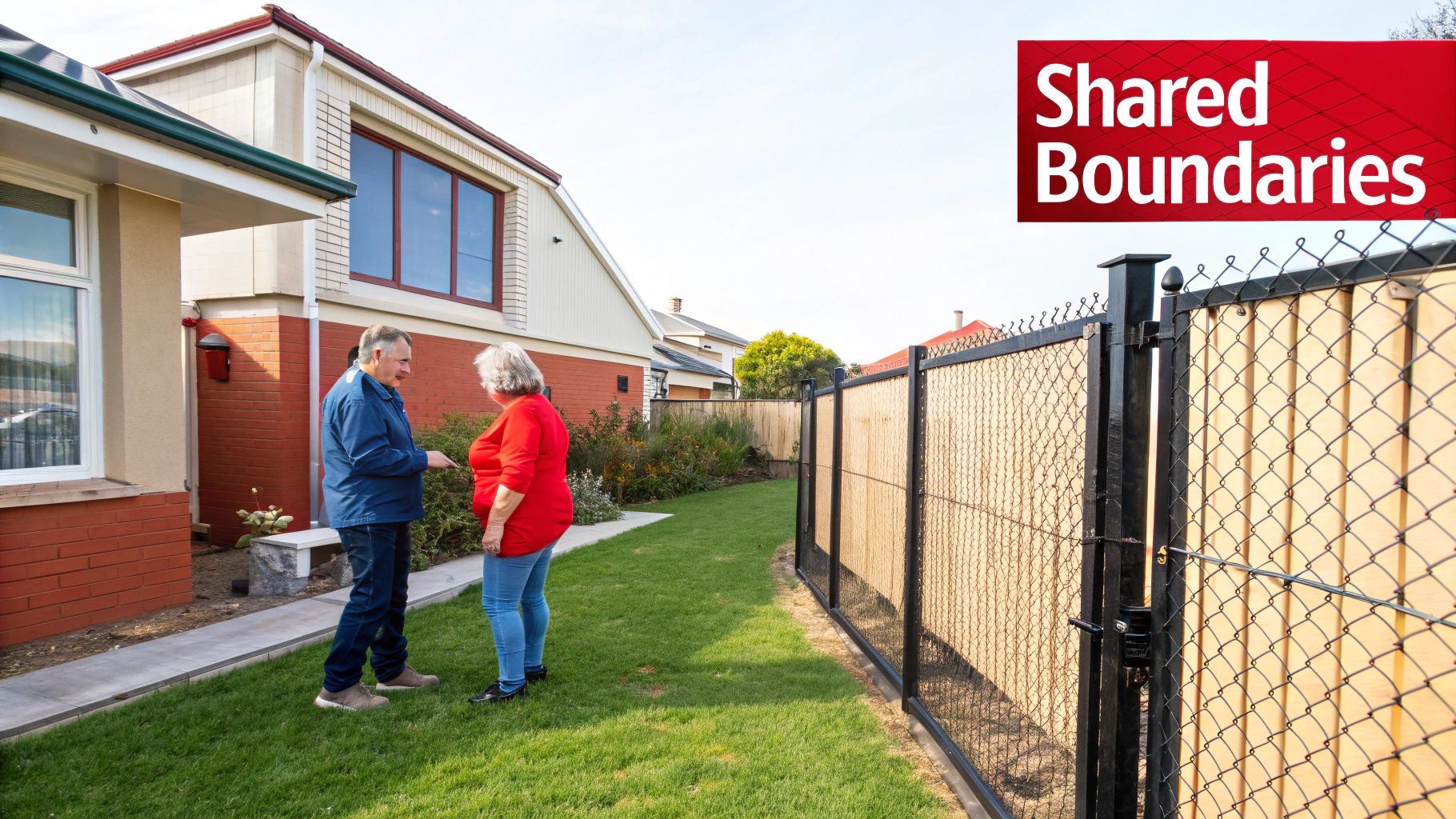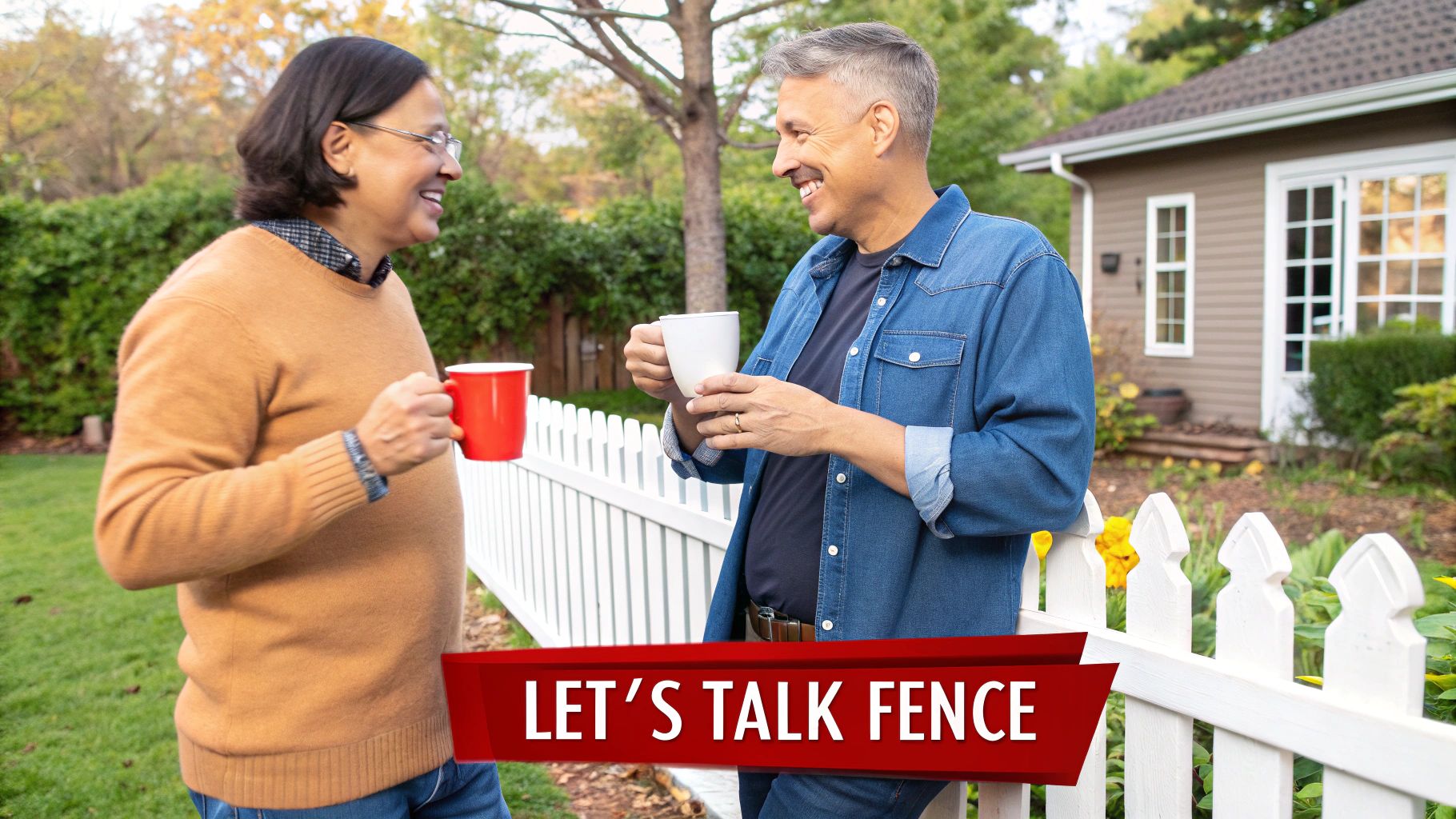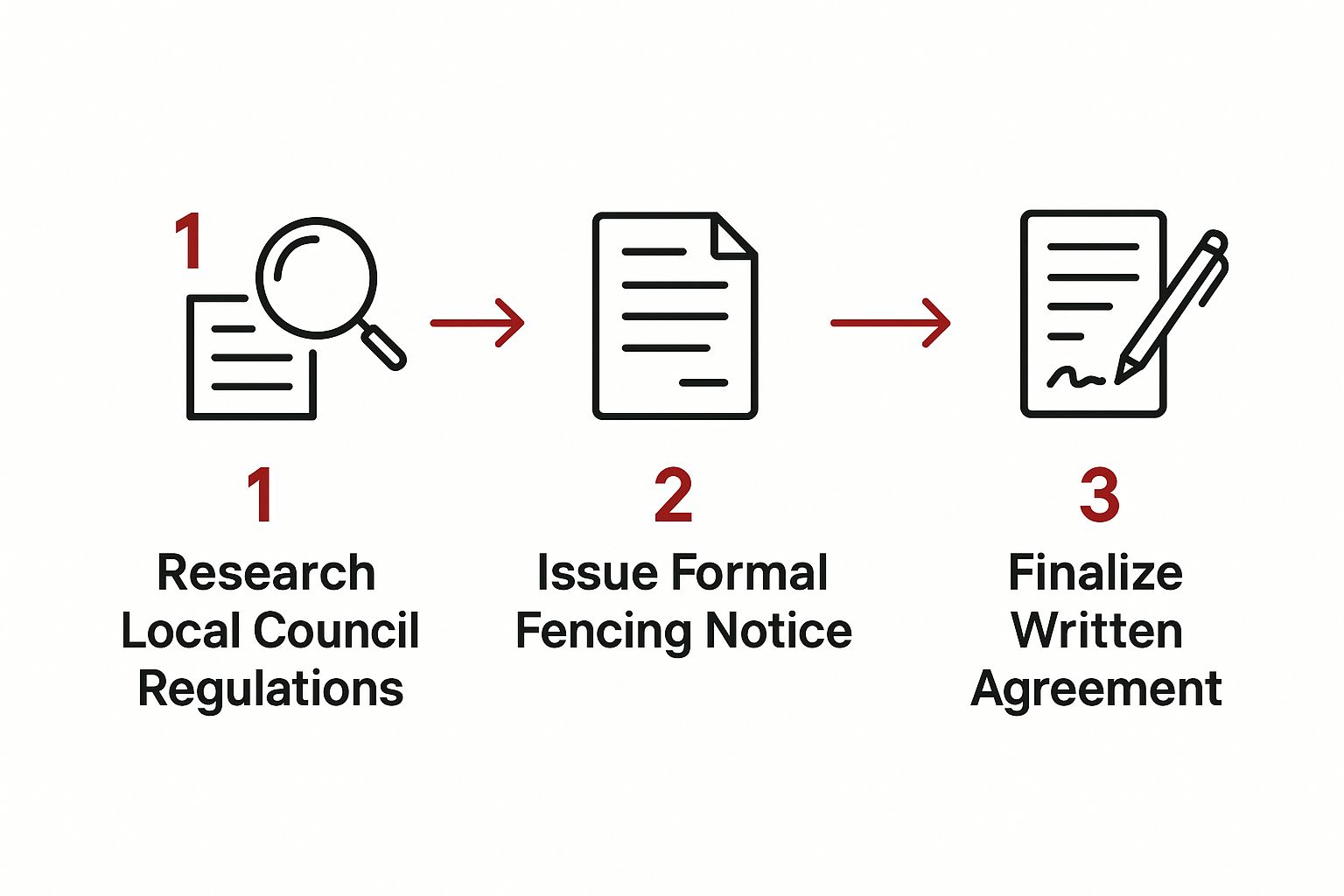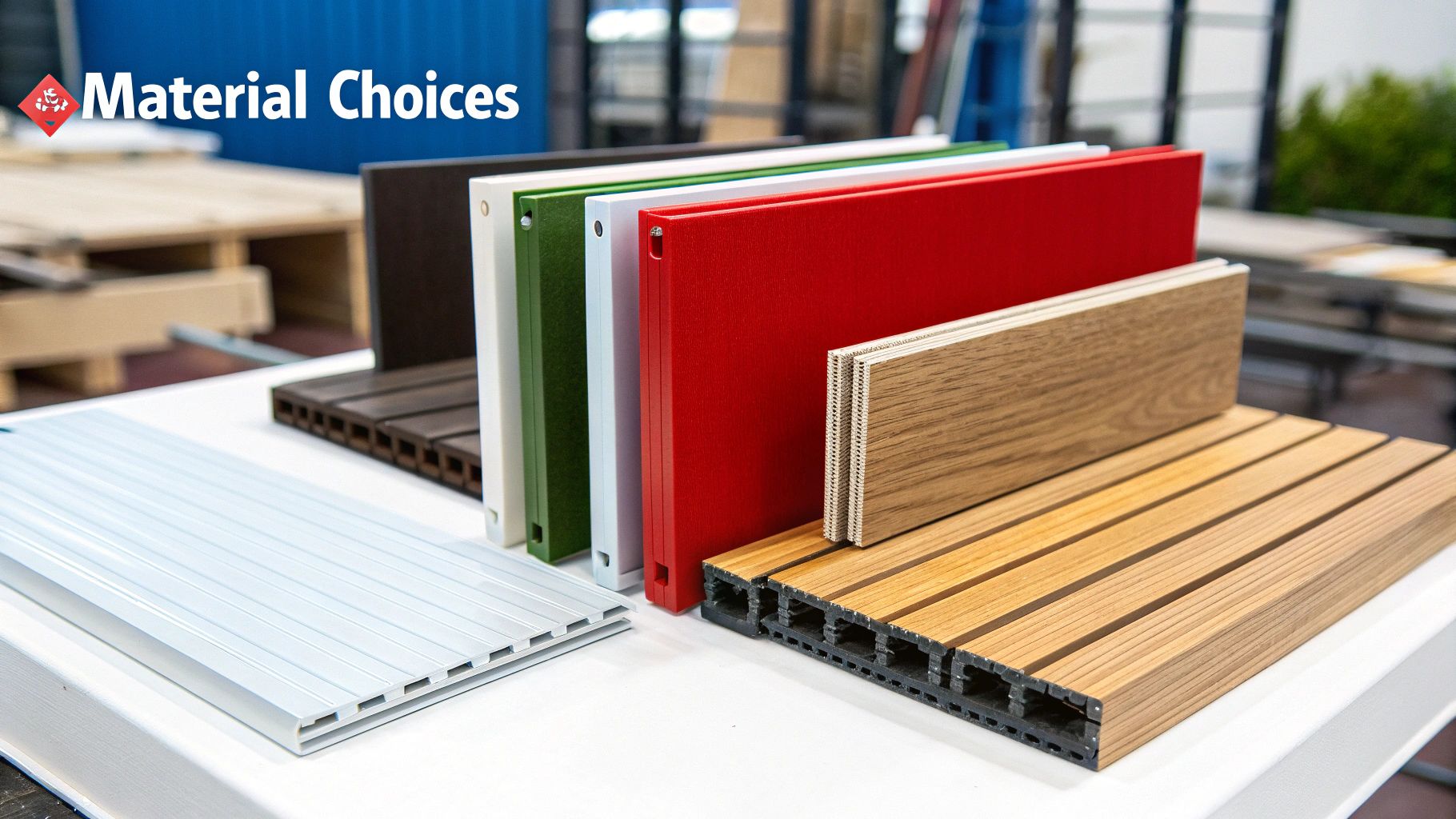A 'neighbour friendly fence' is more than just a line on a map; it's a shared investment that looks great from both sides of the yard and keeps the peace. In Australia, this usually means working together with your neighbour on the design, costs, and installation. Taking this approach turns a potentially stressful job into a positive project that benefits both properties.

Putting up a new fence can feel like a massive task, but the whole idea behind neighbour friendly fencing is to make it simpler. At its heart, it's all about communication and cooperation. Instead of one person calling all the shots, both homeowners team up to pick a fence that works for both homes and budgets.
This isn’t just about being polite; it has deep roots in Australian culture and law. The concept of sharing fencing responsibilities goes way back, with laws like the Dividing Fences Act setting the standard for how neighbours should approach these shared boundaries. This history has built a culture where fences are seen as symbols of cooperation, not division.
A successful neighbour friendly fence project really comes down to a few key things. Open discussion is the big one. Just talking about what you both want—whether it's privacy, security, or a certain style—gets everyone on the same page right from the get-go.
That spirit of cooperation usually carries over to the finances, too. Sharing the cost of materials and labour is common practice and can cut the financial hit for each household by about 50% on average. This shared investment really drives home the point that the fence is a mutual asset. For instance, many suburban homeowners have an informal agreement with their neighbours about fence costs or upkeep.
Going the neighbour friendly route gives you more than just a new fence. It helps build stronger community ties and avoids the kind of arguments that can sour relationships for years. When you work together, you create a solution that genuinely adds value to both properties.
Ultimately, it’s about finding that common ground. You might be after sturdy fence panels for security, while your neighbour is more focused on looks. A collaborative process helps you land on a high-quality, cost-effective solution that ticks everyone's boxes. At Super Rack, we offer a range of durable and competitively priced options perfect for any shared boundary project, with fast delivery right across the country.

Bringing up a new fence can feel a bit awkward, but a friendly, well-prepared approach makes all the difference. The goal is to turn what could be a tricky chat into a collaborative project. A great conversation is the first step toward a successful neighbour friendly fencing outcome.
Timing is everything. Don't ambush your neighbour when they’re wrestling with the bins or rushing the kids off to school. A relaxed weekend afternoon or a casual chat over the current fence is a much better setting. The key is to find a low-pressure moment when you can both talk freely without feeling rushed.
Once you've found a good moment, start the conversation casually. You want to avoid making it sound like a demand or a complaint. The idea is to present it as a shared opportunity, not a problem you’re forcing them to solve.
Here are a few easy ways to get the ball rolling:
These openers are non-confrontational and frame the project as a mutual benefit. It shows you value their opinion right from the get-go.
Expert Tip: Come prepared, but don't come with a final decision. Having some initial research on materials and rough costs shows you're serious, but being open to their ideas is what makes it a genuine partnership.
When you do sit down to talk properly, share the research you've done. Maybe you have some brochures or a few quotes from different suppliers.
This is a great time to mention a provider like Super Rack, known for competitive pricing and superior quality materials. For example, you could say, "I got a rough idea of costs, and places like Super Rack have some really durable options that look good and won't break the bank."
Crucially, after you’ve shared your thoughts, stop talking and listen. Ask them what’s important on their side. Is it privacy? Durability? Aesthetics? Or is budget the main concern?
Understanding their priorities is the key to finding common ground. This collaborative spirit is the foundation of any good neighbourly project, ensuring you find a solution that enhances both properties and keeps the peace for years to come.
Before you even think about digging the first post hole, it’s vital to get your head around the local rules. Every council in Australia has its own playbook for fences, and getting this part right from the start will save you a world of headaches. This isn't just about dodging a fine; it’s about making sure your shared investment is fully compliant and dispute-free.
When it comes to the nitty-gritty, you need to be across the local building codes and regulations. These rules are what will dictate crucial details like the maximum height of your fence, what materials are allowed, and its exact placement relative to the property line.
Your local council’s website is the best place to begin. A quick search for their "fencing guidelines" or information on the "Dividing Fences Act" will usually point you in the right direction.
Beyond the council bylaws, each state has its own version of the Dividing Fences Act. This is the legislation that clearly lays out the legal responsibilities for you and your neighbour. It covers the important stuff: who pays for what, how to navigate disagreements, and the formal steps for getting a fence project officially started.
One of the most important parts of this process is issuing a "fencing notice."
Don't let the name fool you; a fencing notice isn't an aggressive move. It's a standard, formal written document you provide to your neighbour detailing the proposed work. This includes the fence type, the estimated cost (in AUD), and the plan for sharing that cost (which is typically 50/50). Think of it as a professional courtesy that protects both parties and makes sure everyone is crystal clear on the plan before any money changes hands.
The infographic below breaks down the key steps to keep your fencing project legally sound.

As you can see, a structured approach is the best way to sidestep any potential legal tangles down the road.
Once you and your neighbour are on the same page, get it down in writing. A simple, signed document that confirms the agreed-upon design, materials, chosen contractor, and cost-sharing arrangement is non-negotiable. This written agreement becomes your shared source of truth and is invaluable for preventing misunderstandings later on.
It doesn’t need to be a complicated legal contract. A straightforward document should cover:
Taking the time to follow these legal steps might feel like a bit of extra admin, but it’s the best insurance policy you can have. It turns a friendly chat into a clear, actionable plan, ensuring your project is built on a solid foundation of mutual understanding and legal compliance. It’s the single best way to avoid the costly and stressful disputes that often spring from verbal-only agreements.

Picking the right material is a massive step in any neighbour friendly fencing project. The best choice doesn't just look good from your side of the yard; it needs to present a clean, attractive finish from your neighbour's perspective, too. This single decision affects everything from the budget and maintenance to the fence's lifespan and security.
A great result comes from finding a material that balances everyone's priorities. You might be focused on durability and low maintenance, while your neighbour puts a higher value on aesthetics. The good news is, modern fencing solutions offer plenty of options that can satisfy both of you without a big compromise.
Timber is a timeless choice for Aussie backyards, giving off a natural and warm vibe. Treated pine is a solid, budget-friendly option, while hardwoods like Merbau offer a more premium and durable finish. The beauty of timber slat fencing is that it’s easy to design it to look identical from both sides, making it a perfect neighbour-friendly solution.
The trade-off, of course, is that timber needs ongoing maintenance. To keep it looking its best and protect it from the harsh Australian weather, you'll need to stain or paint it every few years. This is a key long-term cost and effort to discuss with your neighbour upfront.
If low maintenance is at the top of your list, aluminium is a brilliant contender. It’s lightweight, incredibly durable, and resistant to rust and corrosion—a huge plus in coastal areas. Aluminium slats or panels create a sleek, modern look that complements many contemporary homes.
While the initial cost for aluminium might be higher than some timber options, its longevity and minimal upkeep often make it more cost-effective over time. It won't warp, crack, or need repainting, saving both you and your neighbour a lot of time and money down the track.
A great fence is a long-term investment in both properties. Choosing a high-quality material from a reputable supplier like Super Rack ensures you're getting a product built to last, providing a superior return on investment through durability and minimal future costs.
For those who see security and strength as the main goals, it's hard to go past steel fencing. It provides a formidable barrier and is incredibly long-lasting. While some steel designs can look a bit industrial, there are plenty of modern styles available that are both secure and easy on the eye.
The secret to a long-lasting steel fence is quality construction and proper installation. Investing in high-quality components, like sturdy metal fence poles, is crucial for ensuring your fence stays structurally sound for years to come. At Super Rack, our commitment to superior quality means you get competitively priced products that don’t compromise on strength, backed by expert advice and nationwide service.
So, how do you make the final call? It comes down to weighing these factors together. Have a chat with your neighbour about the following:
By talking through these points openly, you can land on a material that enhances both properties, meets everyone's needs, and stands as proof of your good neighbourly relationship.
With the big decisions on style and materials sorted, it’s time to nail down the logistics. A little bit of careful planning now is the key to a hassle-free installation, making sure your neighbour friendly fencing project gets over the line without any dramas. This is where you coordinate timelines, formalise what you've agreed on, and handle all the on-the-ground details.
Whether you’re bringing in a professional or tackling the job yourself, having a shared timeline is non-negotiable. Have a chat with your neighbour about what works for both of you. You'll want to think about things like work schedules, school holidays, or any upcoming family events that might make having construction going on a bit of a pain.
A handshake is a good start, but a simple written document is your best friend when it comes to avoiding future misunderstandings. It doesn't need to be a complex legal contract—just a clear, straightforward summary of everything you've both agreed to. Think of it as a shared reference point for the whole project.
Your agreement should clearly lay out:
Putting it all in writing transforms a casual chat into a concrete plan. It ensures everyone is on the same page about the money and expectations, which is absolutely crucial for keeping things positive with your neighbour.
With a solid plan in place, you can move on to the real-world logistics. One of the first things to sort out is property access. If you're hiring installers, they’ll need clear and easy access to the boundary line. This might mean temporarily opening up parts of your garden or your neighbour’s.
It’s best to discuss this well in advance to avoid any surprises on the day. You should also talk about how to protect garden beds, lawns, or any other landscaping near the fence line during construction. A few tarps over plants or temporarily moving some pots can prevent a lot of accidental damage.
If you’re hiring professionals, it’s a good idea to understand the real cost of a general contractor to make sure you’re getting a fair price. Finding reliable tradespeople is just as important. For guidance on this, Super Rack has a great resource on finding the best fencing contractors near you. Our network can connect you with trusted experts who know what quality workmanship is all about.
At Super Rack, we’re not just about superior products. We're here to help you get a smooth project from start to finish, offering expert advice nationwide.
Once the last post is in, the job isn't quite done. A shared fence is a long-term commitment, not just to a physical structure, but to your relationship with your neighbour. A truly great neighbour-friendly fencing project keeps going long after the installation, all thanks to a simple, agreed-upon maintenance plan.
It's far easier to sort this out now, while you're both happy with the brand-new fence, rather than having an awkward chat when a repair is urgently needed. Putting a plan in place from the get-go prevents misunderstandings down the track.
Think of this as the final, friendly handshake on your project. A quick chat about future upkeep makes sure everyone is on the same page. This doesn't need to be a formal legal document; it's just about having a clear understanding of who does what and when.
Your chat should probably cover a few key areas:
By discussing maintenance upfront, you’re reinforcing the spirit of cooperation that got the project started. It shows you're both invested in the fence's longevity and in keeping things positive and respectful for years to come.
This bit of forward-thinking turns your fence into a lasting symbol of a great community connection, not a future headache. Of course, the best way to minimise future work is to choose a durable, low-maintenance material from the start. High-quality fencing requires far less upkeep over its lifespan, saving both of you time and money.
For durable, low-maintenance options that stand the test of time, talk to the experts at Super Rack. Our superior quality products and competitive pricing ensure you get a fantastic result that keeps everyone happy for years to come. Explore our solutions at https://www.superrack.com.au.
4000 to 4182
4186 to 4207
4300 to 4305
3000 To 3096
3098 To 3112
3114 To 3138
3140 To 3157
3161 To 3198
3200 To 3207
Let's connect